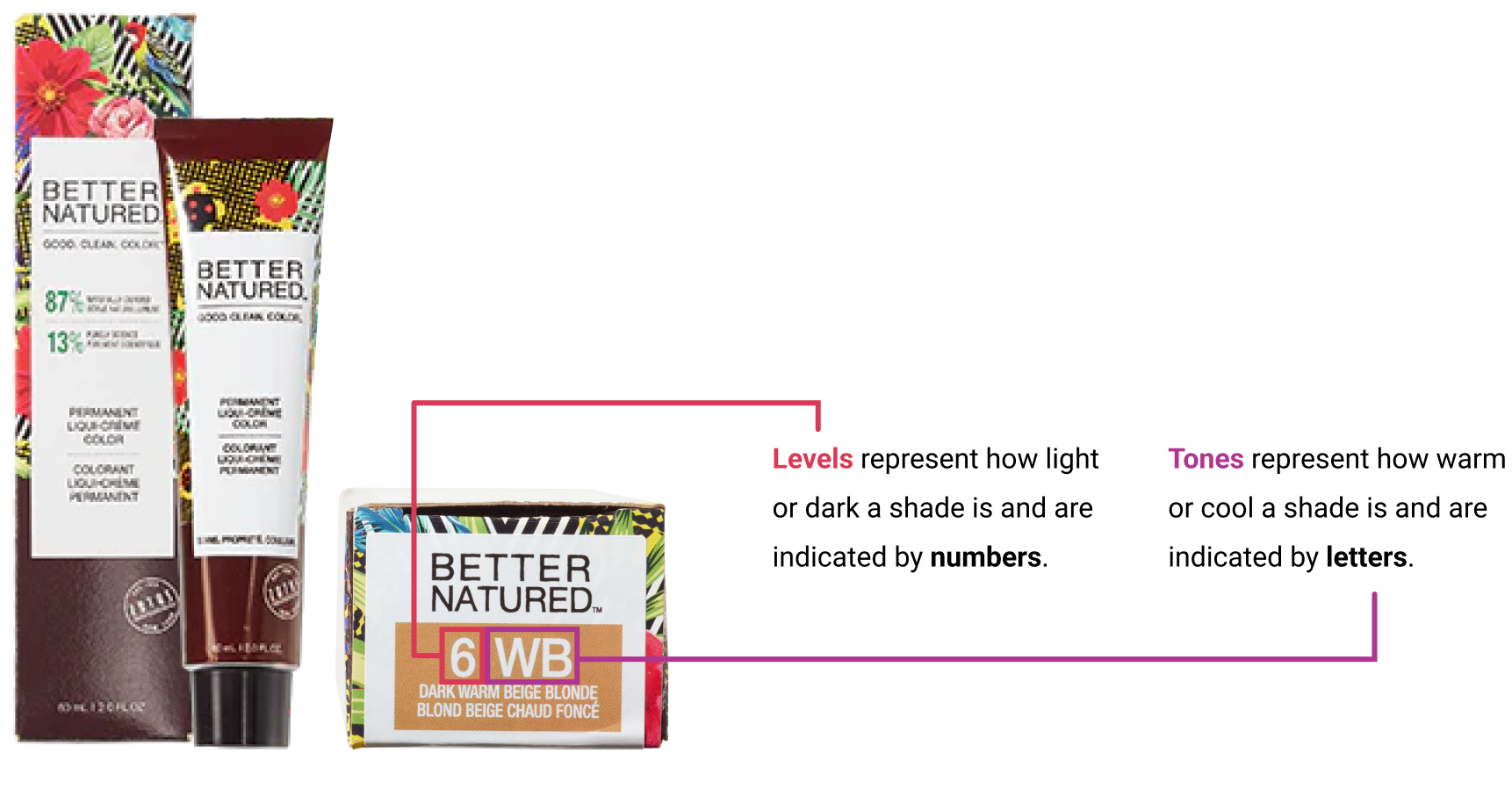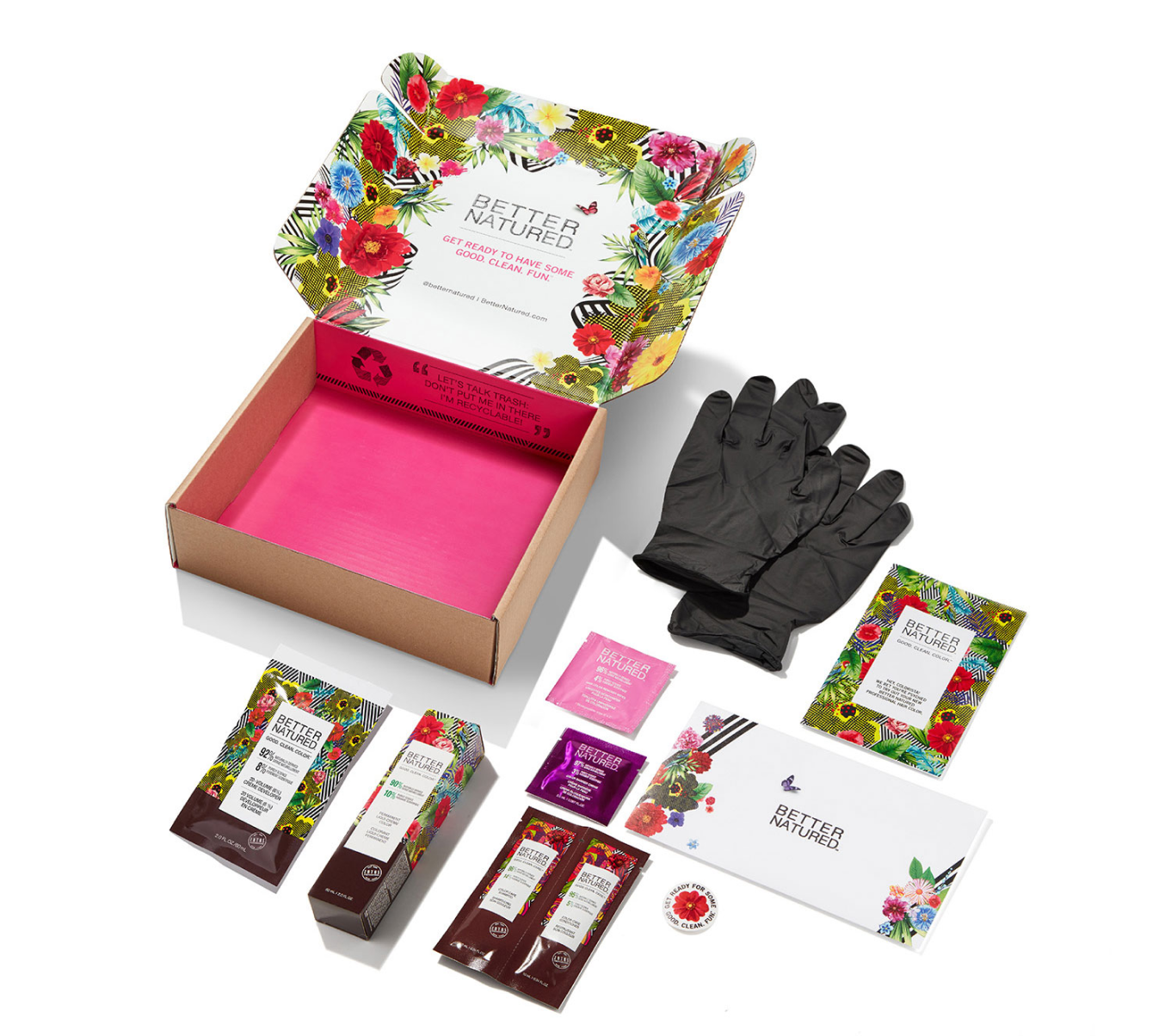Levels and Tones:The Basics

Hair color is all about levels and tones—so if you want to find your made-for-me shade (and honestly, who doesn’t?), you’ve gotta find the right combo of both.
View our shade chart
Levels represent how light or dark a shade is and are indicated by numbers.
Tones represent how warm or cool a shade is and are indicated by letters.
Ready to dive in a bit deeper? Put on your swimsuit, here we go!
On The Level From Dark To Light
The level system is a range of hair color shades from dark to light. This system of levels is used by hair color manufacturers to communicate the darkness or lightness of a shade. Better Natured hair color levels range from 1-10, with 1 being the darkest (black) and 10 being the lightest (lightest blonde).
Why You Should understand the Language of Levels
When you’re talking hair color, it’s important to understand the language of levels—because “level 4” means the same thing as “medium brown hair” and “level 7” means the same thing as “medium blonde hair” making it lot less vague when selecting a shade. (And nobody wants vague when it comes to hair color.)
Knowing your natural level (or, if your hair is already colored, your current level) helps you figure out the shade you need to get the results you want. Many people think “natural hair color” refers to the shade you were born with, or the shade you were as a hair color virgin. But hair tends to change color as we age, so be sure to go by your current natural hair color.
FIND YOUR LEVEL
DARKEST TO LIGHTEST
To figure out your natural level:
- Grab a section of your hair and hold it away from the rest of your hair. (Hair always looks darker when it’s layered against other hair, so pulling a section out is more accurate.) The section should be from as far back in the crown as you can hold up and see (no need to go as far as the nape).
- Then, match what you see with the closest number on our chart above, and voilà! You’ve found your level.
FYI: Your hair is always lightest around the front hairline where it’s finer and gets the most sun exposure. So, using a section from your hairline roots may skew your results to be darker than expected. (Hard pass on that!)
Need advice? ask our licensed colorists



KNOW YOUR GRAYS
Knowing the amount of gray in your hair is super helpful in finding your starting level. Colorist refer to a percentage range to determine the amount of gray (white) hair, the more the gray (white) hair the higher the %.
 Using our chart provided to determine your % of gray (white) hair.
Using our chart provided to determine your % of gray (white) hair.
-
 25%
25%
-
 50%
50%
-
 75%
75%
-
 100%
100%
DID YOU KNOW: Those hairs aren’t actually gray? Gray color is an optical illusion caused by the white hair living side by side next to the natural color hair that makes it appear gray.


LEVEL UP OR DOWN
Once you know your natural starting level, decide which way you want to go from here.
Going Lighter? Know Your Limits
Better Natured Permanent Liqui-Crème Color with 20-Volume Developer lifts 1-2 levels, depending on the shade you choose.
Going Darker?
What You Need to Know to Be Safe
Darken your hair gradually over time rather than going all out, all at once. (There’s such a thing as too much drama.)
Looking to keep grays at bay?
We hear that. Better Natured delivers impeccable gray coverage and that gorgeous color will last for up to 8 weeks!
(You’re welcome.)
TO EACH HER TONE about hair color tones
Now let’s talk tone! We’ll start with a quick science lesson:
Every natural hair color is some combination of black, brown, yellow, and red.
Tones range from warm to cool, and are represented by a letter. For example, in the shade “8G,” the 8 stands for level 8 (Blonde), the G stands for tone (Golden).



Underlying Pigment
When coloring your hair lighter, warm tones are naturally exposed during the dyeing process, colorists refer to these naturally exposed warm tones as “underlying pigment”. You can choose to enhance the underlying pigment by choosing a warm tone shade or neutralize the underlying pigment by choosing a cool tone shade.
View our color wheelachieve tone perfection:Check out your complexion – warm tones can help enhance color, while cool tones can take redness down a few notches. When in doubt? Go the natural route.

PUTTING IT TOGETHER LEVEL & TONE
A few everyday color scenarios to show how level & tone work together for your optimal hair color shade.
Scenario 1
I feel my hair is dull & too dark…. I want to be lighter & brighter.
First, using the guides provided I figure out my natural hair color is a natural level 3 (Dark Brown) and I am less than 25% gray.
Next, I figure out how light I should go, I count-up two levels from level 3 to level 5: Level 5 (light brown).
Since I want my hair to be brighter, I am going to choose the G (golden) tone to enhance my underlying pigment for a warm color result: Tone G (golden).

Scenario 2
I want my hair lighter, but I hate seeing any warmth, or brassy tones in my hair. I want my color result to be as cool as possible.
First, using the guides, I figure out my natural hair color is a level 6 (Dark Blonde) with no grays.
Next, by figuring out how light I should go, I count-up two levels from level 6 to Level 8: Level 8 (Dark Blonde).
Since I don’t want any warm tones in my hair I am going to choose, BA (Blue-Ash) tone to neutralize my underlying pigment for a cool tone result. Tone BA (Blue-Ash)

HAIR COLOR CHEAT SHEET
Study these 7 quick tips and you’ll pass any hair color quiz with flying colors!














